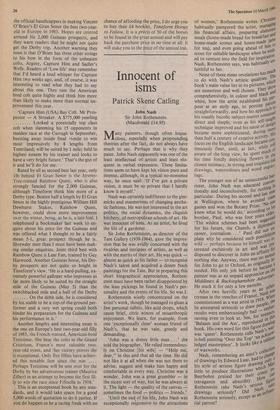Innocent of isms
Patrick Skene Catling
John. Nash Sir John Rothenstein (Macdonald £14.95)
Many painters, though often loqua- cious, especially when propounding theories after the fact, do not always have much to say. Perhaps that is why they paint. John Nash apparently was one of the least intellectual of artists and least elo- quent in verbal expression. These limita- tions seem to have kept his vision pure and intense, although, in a typical no-nonsense way, he once said: 'If I've got a private vision, it must be so private that I hardly know it myself.'
Nash was certainly indifferent to the gim- micks and mannerisms of changing aesthe- tic fashions. He was not interested in the art politics, the social dynamics, the cliquish bitchery, of metropolitan schools of art. He was innocent of isms. As an artist, he lived the life of a gardener.
Sir John Rothenstein, as director of the Tate Gallery (1938-1964), gave the impres- sion that he was avidly concerned with the rivalries and intrigues of artists, as well as with the merits of their art. He was quick almost as quick as his father — to recognise Nash's talent and acquired a dozen Nash paintings for the Tate. But in preparing this short biographical appreciation, Rothen- stein must have been rather disappointed by the lean pickings he found in Nash's per- sonality and the events of his life. So was I.
Rothenstein wisely concentrated on the artist's work, though he managed to glean a few personal tidbits, like acid drops, which cause brief, citric winces of misanthropic enjoyment. We learn, for example, from one 'exceptionally close' woman friend of Nash's, that he was vain, greedy and demanding.
`John was a dressy little man ...' she told the biographer. 'He relied tremendous- ly on Christine [his wife] — "Help me, dear," in this and that all the time. He did not like it at all when she was not there to advise, suggest and make him happy and comfortable in every way. Christine was a wonder. John was a great grumbler — in the nicest sort of way, but he was always at it. The light — the quality of the canvas sometimes the food — politics — friends.'
'Until the end, of his life, John Nash was exceptionally responsive to the attractions
habitually pampered the 'artist, managing his financial affairs, preparing elaborate
meals (home-made bread for breakfast and home-made scones and home-made jahl.5 for tea), and even going ahead of him to scout for suitable landscapes when he wish- ed to venture into the field for inspiratt°fl' Nash, Rothenstein says, was habitually Un- faithful to her. None of these mean revelations has Much to do with Nash's artistic qualities. Thhe book's main value lies in its pictures, whic are numerous and well chosen. They sh° comprehensively, in colour and black and white, how the artist established his pur- pose at an early age, to portray tilature straightforwardly, and how his approach his usually bucolic subject-matter remained direct and simple, even as his self-taut technique improved and his sense of desiga became more sophisticated, during 01„.°I.e: than half a century of creative activity. 01' focus on the English landscape became c°?,, tinuously finer, until, at last, while stile' aware are of the long view, he spent much 131e his time fondly depicting flowers !hi, closest intimacy, in strong and exquisite la" drawiqgs, watercolours and wood engray ings.
. The younger son of an unsuccessful bar,
nster, John Nash was educated convet tionally and inconclusively, for nothulgeor' particular. During his second and last 3:,,„n at Wellington, where he avoided tile games and won the Botany Prize, `N° °his knew what he would do,' according brother, Paul, who was four years older brother,
wildest schemes had been suggest.:e
for his future, the Church, a diP1°Maegit career, journalism ...' Paul did 11.0,t ..hes plain why he considered such possihthin„ wild — perhaps because he himself was re, terested exclusively in art and was Pfar disposed to discover in John an affilutY„ey nothing else. Anyway, there was no (Olio, for John to go to Oxford, as origina_,11Ye a tended. His only job before he became Middlesex wexasciasBaunckuinnpgahiadmasphpirer e nAt idcev eor jr He stuck it for only a few months. for After two horrific years as an Ihriviss tryman in the trenches of France, Nash commissioned as a war artist in 1918',rn tbe he attempted seriously to draw Pe°Pie'bar- results were embarrassingly bad e,ce, rassing even to look at. See, for las,t'As `Balaam and the Ass', reproduce invii;$ book. His own word for this figure clraviar. w as 'queer'. Rothenstein calls Nash ic5000- is-hell painting 'Over the Top' 'all
ledged masterpiece'. It looks like a `•"' of waxworks. tieetion
Nash, remembering an aunt's coargte of drawings by Edward Lear, had too ily his style of serious figure drawing gag little to produce illustrations whicl!c Beerbohm praised for their coi V' l" tali travagance and absurdity. W flare Rothenstein take Nash's serious toe drawings seriously? Did Nashinfluea" Rothenstein seriously, except as an '-
dal patron?






































 Previous page
Previous page